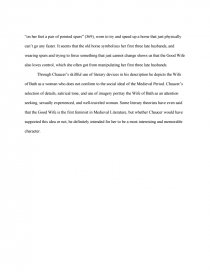The Good Wife - Chaucer
Essay by dhxx • April 27, 2016 • Essay • 541 Words (3 Pages) • 1,127 Views
It is a truth universally acknowledged that a single woman in possession of good looks must be in want of a husband. Or maybe five. Though Chaucer’s satirical tone, selection of details, and symbolic imagery, the Canterbury Tales’s Wife of Bath is portrayed as having an independent nature that distinguishes her as one of the first liberal women in English Literature.
Firstly, it is apparent that Chaucer uses a satirical tone to communicate between the lives that he does not approve of the Good Wife’s behavior. He tells the reader about how “No parish wife would dream of such a thing / As going before her with an offering,” because it would “put her wholly out of charity” (345-346, 347). Offerings, which are meant to be offered to God out of thankfulness, do not seem to have the same purpose to the Wife of Bath. As one person’s offerings should not affect another’s, the fact that Chaucer mentions that the Good Wife would be put of charity if she was not seen by other members of her parish when giving her offerings lets us know that he is being sarcastic and satirical in his description.
Differently than a number of the other pilgrims in the Canterbury Tales, most of what the reader learns about the Wife of Bath is about her apprearance. A seamstress with “such a great skill in making cloth she spent / That she surpassed the folk of Ypres and Ghent” (344-345), the Good Wife makes her own clothing, choosing to dress herself in luxurious and flashy clothing despite the fact that she is going on a religious pilgrimmage. The image that Chaucer gives the reader about the Good Wife helps us to better understand her character as one who uses her looks to attract people, particularly men.
Again, Chaucer gives readers an image of the Good Wife to that is meant to reveal more about her character. Even though we know her to have money, readers are given the image of the Good Wife riding along on the pilgrimmage on what is described to be “a gentle, ambling nag” (365), which seems to not match someone of her personality. Not only that, but she also wears “on her feet a pair of pointed spurs” (369), worn to try and speed up a horse that just physically can’t go any faster. It seems that the old horse symbolizes her first three late husbands, and wearing spurs and trying to force something that just cannot change shows us that the Good Wife also loves control, which she often got from manipulating her first three late husbands.
Through Chaucer’s skillful use of literary devices in his description he depicts the Wife of Bath as a woman who does not conform to the social ideal of the Medieval Period. Chaucer’s selection of details, satirical tone, and use of imagery portray the Wife of Bath as an attention seeking, sexually experienced, and well-traveled woman. Some literary theorists have even said that the Good Wife is the first feminist in Medieval Literature, but whether Chaucer would have supported this idea or not, he definitely intended for her to be a most interesting and memorable character.
...
...

